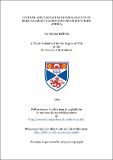Files in this item
Lithium and tantalum mineralization in rare-element pegmatites from southern Africa
Item metadata
| dc.contributor.author | Baldwin, Joy Rosina | |
| dc.coverage.spatial | 314p, 45p of plates. | en_US |
| dc.date.accessioned | 2018-07-17T10:35:39Z | |
| dc.date.available | 2018-07-17T10:35:39Z | |
| dc.date.issued | 1994-07 | |
| dc.identifier.uri | https://hdl.handle.net/10023/15468 | |
| dc.description.abstract | Lithium and tantalum mineralization in rare-element pegmatites has been studied in 4 field areas. Three field areas are within a pegmatite belt which stretches for 450 km from Steinkopf, Namaqualand in the west, to Kenhardt in the east along the Orange River in South Africa, incorporating Tantalite Valley, Namibia in the central area. This Belt is considered to be of 1200 my age. The 4th field area is in central Namibia in the Karibib-Usakos region of 500 my age. Lithium mineralization involves primary minerals, petalite and spodumene (crystallizing< 650° C) and amblygonite which crystallize from a magma +/- an aqueous fluid, and lithian mica which along with cleavelandite is one of the last mineral assemblages to form, probably these last two assemblages are replacement in origin. Petalite is dominant in the Karibib area and spodumene in Steinkopf, Namaqualand and Tantalite Valley. The Kenhardt area is poor in lithium in comparison with the western and central portions of the Pegmatite Belt. Amblygonite-montebrasite is present in Karibib and Tantalite Valley usually in association with cleavelandite and lithian mica. Hydrothermal low temperature replacements, < 400°C occur in spodumene in the Steinkopf and Tantalite Valley pegmatites, being pseudomorphed by albite and mica +/- sericite. Amblygonite-montebrasite in Karibib displays replacements of natromontebrasite (the first occurrence in Karibib, Namibia), crandallite, brazilianite and possibly cookeite. Apatite is always prominent at the contact. An unusual occurrence of Mn-tantalite lamellae, primarily parallel, lying in microlite, is intergrown with montebrasite at the Rubicon pegmatite, Karibib, suggesting simultaneous crystallization of these three minerals, i.e. Ta-dominated tantalite and microlite and LiAl(F/P04) involving late fluids rich in F, P and Ta. Mn-tantalite and Ta-rich microlite are the dominant Ta-minerals in the rare-element Li-rich pegmatites of Namaqualand, Tantalite Valley and Karibib. In contrast, columbite (Nb-rich) is prevalent in the Li-poor, less differentiated pegmatites in the eastern Pegmatite Belt near Kenhardt. Microlite replaces Mn-tantalite in Li-rich rare-element pegmatites in all three field areas. A uranmicrolite from Karibib, Namibia contains 14.35% UO2, 1.03% PbO, 56.12% Ta205, 13.18% Nb205, 0.58% Fe203, 6.87% CaO, 0.54% SrO, 0.59% MnO, 0.86% Na2O and 0.47% F. U-plumbomicrolite or Pb-uranmicrolite is intergrown with manganotantalite from the same pegmatite. Throughout one aggregate of microlite PbO varied from 21.98 to 1.57% and UO2 from 12.89 to 16.20%. Pb appears to be concentrated around the periphery of the crystal. Backscattered electron images reveal metamict textures in radioactive microlites and distinctive subspheroidal features. A uranoan microlite from Tantalite Valley, Namibia, revealed two essentially different compositions; a more hydrated rim area of 200 mum radius containing 7% higher Ta2O5, 10% lower CaO and 1.3% lower F than a main central area of slightly variable composition. Crystals of uranoan microlite from Steinkopf, Namaqualand contain remnants of a bismuth phase. Bismuth intergrowths with quartz reveal the presence of two rare-minerals, pyromorphite [Pb5(PO4) 3 C1] and m0ttramite[PbCu(VO4)OH], new data is given for these minerals. Ferro tantalite occurs at Rubicon mine. A schematic diagram is produced for the paragenetic sequence of mineral assemblage in each of the pegmatite areas in Karibib, Tantalite Valley, and Steinkopf, Namaqualand in relation to T and P of formation, and the magma and fluids effecting the crystallization sequence. Finally different fractionation trends of Ta-Nb, Mn-Fe, Rb-K and Cs-K in columbite-tantalites and lithian mica have highlighted variable paths of differentiation in contrasting rare-element pegmatites which may reflect different sources of original parental magma. | en_US |
| dc.language.iso | en | en_US |
| dc.publisher | University of St Andrews | |
| dc.subject.lcc | QE462.P4B2 | |
| dc.subject.lcsh | Pegmatites | |
| dc.title | Lithium and tantalum mineralization in rare-element pegmatites from southern Africa | en_US |
| dc.type | Thesis | en_US |
| dc.type.qualificationlevel | Doctoral | en_US |
| dc.type.qualificationname | PhD Doctor of Philosophy | en_US |
| dc.publisher.institution | The University of St Andrews | en_US |
This item appears in the following Collection(s)
Items in the St Andrews Research Repository are protected by copyright, with all rights reserved, unless otherwise indicated.

